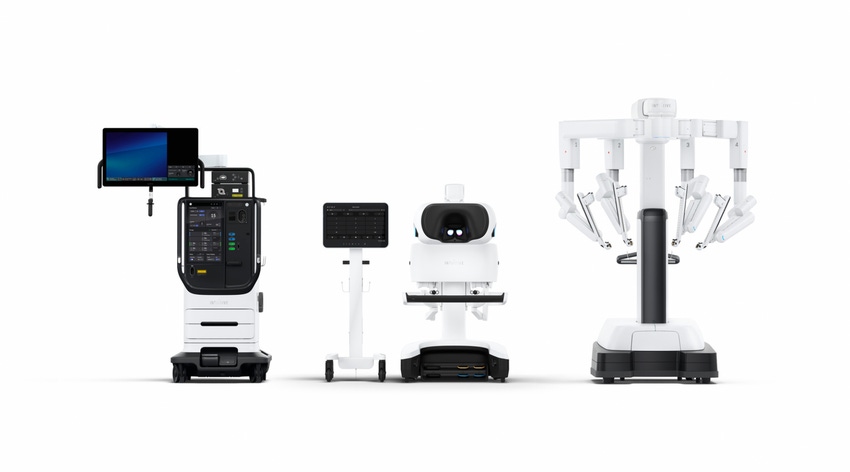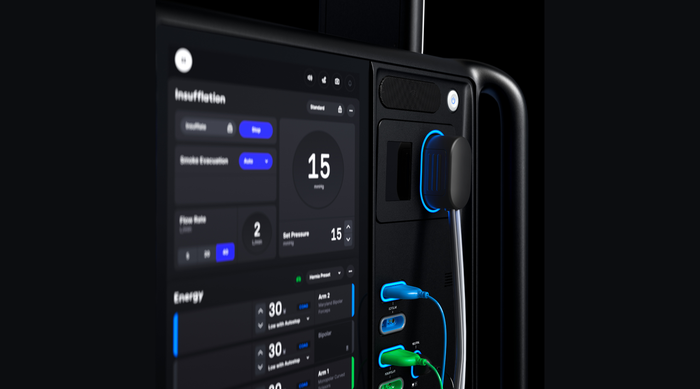Not a Moment Too Soon: FDA Clears Intuitive Surgical's New Robot
The highly anticipated milestone comes as the robotic surgery market is more competitive than ever before.
March 15, 2024

At a Glance
- The da Vinci 5 will initially be available only to a small number of U.S. customers before a wider commercial launch
- The new system is designed with more than 150 enhancements over the company's da Vinci Xi system.
- Intuitive will host a conference call Monday morning to discuss the da Vinci 5 in more detail
In what could be called a turning point for robotic surgery, FDA has cleared da Vinci 5, the latest surgical robotics system from market pioneer Intuitive Surgical.
Intuitive's investors had been growing restless for news of a new multiport da Vinci system until three weeks ago, when CEO Gary Guthart confirmed that the company has been quietly working through the FDA process for the da Vinci 5.
The company is expected to discuss the da Vinci 5 features and benefits, along with launch plans, during a conference call Monday morning. In the meantime, here is what we know about the new robot:
Only select robotic surgeons will have access to da Vinci 5 for some time

Intuitive Surgical's da Vinci 5 tower. IMAGE COURTESY OF INTUITIVE SURGICAL
Intuitive said the da Vinci 5 will initially be available only to a small number of U.S. customers who collaborated with the company during the development period and to those with mature robotic surgery programs. This limited launch will enable the company to work with its early adopters to generate additional data on the system's use before a wider commercial introduction.
"We strive to provide customers with technology that meets their needs and solves important problems," said Myriam Curet, MD, chief medical officer at Intuitive Surgical. "We intend to launch da Vinci 5 more broadly in the U.S. and globally after we learn from and work with an initial smaller number of customers directly.
Intuitive has designed da Vinci 5 with a whopping 150 enhancements
At the J.P. Morgan Healthcare Conference in January, Guthart said the company would not rush a new system to market without making a meaningful change to the technology. With a whopping 150 enhancements, it seems he was serious about that commitment.
“Intuitive is committed to meaningful improvements in surgery that enable better patient outcomes, enhance the patient and care team experiences, and ultimately lower the total cost of care. After more than a decade of careful research, design, development, and testing, we believe da Vinci 5 will deliver on these goals and help drive the future of robotic-assisted surgery," Guthart said.
The enhancements, according to the company, include:
Improved accuracy and precision: da Vinci 5 is designed with new surgeon controllers and powerful vibration and tremor controls, making it the smoothest and most precise system Intuitive has developed to date.
Next-generation 3D display and image processing: da Vinci 5 is equipped with Intuitive’s highest quality and most natural 3D imaging system, enabling surgeons to see more today and supporting future generations of surgical endoscopes and vision software as those technologies evolve.
Force-sensing technology: Intuitive said its da Vinci 5 introduces Force Feedback technology and optional instruments designed to enable the system to measure, and surgeons to feel, subtle forces exerted on tissue during surgery. In preclinical trials with surgeons at all experience levels, Force Feedback demonstrated up to 43% less force exerted on tissue, which may translate to less trauma on tissue. The company noted that the ability to measure this force adds an important new data stream to surgical data science, which can bring future analytical insights supported by artificial intelligence. These optional Force Feedback instruments are cleared for use in the same procedures as da Vinci Xi, except pediatric and cardiac procedures, and there is a specific contraindication for the Force Feedback needle driver for use in suturing during hysterectomy and myomectomy procedures.
Throughput and workflow enhancements: da Vinci 5 has features designed to help increase surgeon autonomy and streamline surgeon and care team workflow. For example, da Vinci 5 has integrated key OR technologies, including insufflation and an electrosurgical unit. The system also includes an optimized user interface, with settings that are accessible by the broader surgical team and by the surgeon directly from the head-in menu. Surgeons have access to other key settings while head-in to help them stay focused on the surgical field. All of this, theoretically, translates into faster procedure times.
Expanded computing power and advanced data capabilities: The new multiport system has more than 10,000 times the computing power of da Vinci Xi (Intuitive's fourth-generation system). This enables new system capabilities and advanced digital experiences, now and in the future, including integration with Intuitive’s My Intuitive app, SimNow (a virtual reality simulator), Case Insights (a computational observer), and Intuitive Hub (edge computing system).
Greater surgeon comfort: The da Vinci 5 system features a redesigned console capable of customizable positioning, allowing surgeons to find their best fit for surgical viewing and comfort, including the ability to sit completely upright. The surgeon can make any necessary adjustments while their head is in the console, with options designed to fit different body types, including surgeons who are pregnant.
What medtech analysts are saying about da Vinci 5
William Blair's Brandon Vazquez said in a report issued early Friday morning that he is bullish on long-term growth potential based on his initial read on the da Vinci 5 announcement.
First, based on his team's November 2023 survey, Vazquez said the da Vinci 5 checks the box of at least three of the top four most requested features by bariatric surgeons (the analyst notes these surgeons are largely representative of general surgery use cases). Those three boxes are decreased footprint, haptic feedback, and console ergonomics.
"We think this can help drive incremental demand for the system and raise the bar for competition in the future," Vazquez wrote.

Intuitive's da Vinci 5 has integrated key OR technologies, including insufflation (shown here) and an electrosurgical unit. IMAGE COURTESY OF INTUITIVE SURGICAL
The analyst also said a streamlined workflow with da Vinci 5's integrated insufflation and electrosurgical units, as well as new heads-up displays, can potentially reduce procedure times and the cost of each procedure. These benefits in turn can incentivize hospitals to convert additional surgical volumes to da Vinci, Vazquez wrote.
BTIG's Ryan Zimmerman raised some interesting questions regarding da Vinci 5 (Dv5) potential to move the needle.
"If Dv5 can speed up procedures this would create additional capacity and drive I&A sales higher," Zimmerman wrote in his report, issued Thursday evening. "We know the Dv5 computing power will be leaps ahead of Xi and feedback is starting to emerge from a few KOLs, but there is only so much time in the day and no matter how smart a robot may be, humans can only prep an OR so fast or turn around an OR regardless of technology."
To gain better insight into the utilization factor, Zimmerman and team conducted an interesting analysis on Intuitive Surgical’s utilization rate (procedures per system per quarter), which has steadily increased over the past couple decades. The analyst estimates that Intuitive is currently averaging about 70 procedures per system per quarter. The analysis assumes one da Vinci unit per operating room and roughly 91.25 total days per quarter.
“When we think about capacity in an operating room, we consider the following items as key factors: operating room hours in a day, operational days per quarter, and average procedure times,” Zimmerman wrote. “...The first three are flexible. Facilities can run operating rooms longer in a given day, a facility could add on cases during the weekend, or case times could go faster (a result of [the company’s] efforts to improve workflow efficiency) and one of the biggest drivers to achieving increased ROIC for hospital customers."
So, what did BTIG's analysis show?
“In short, we believe [Intuitive Surgical] has a lot of headroom to keep growing utilization,” Zimmerman wrote.
The analyst added that even under conservative assumptions, he sees capacity per operating room well ahead of current utilization.
About the Author(s)
You May Also Like



.png?width=300&auto=webp&quality=80&disable=upscale)
